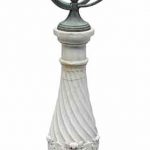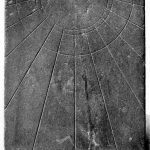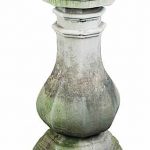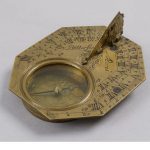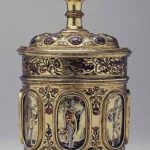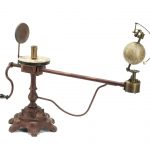Sundials. The earliest sundials known from the archaeological record are shadow clocks (1500 BC or BCE) from ancient Egyptian astronomy and Babylonian astronomy. Presumably, humans were telling time from shadow-lengths at an even earlier date, but this is hard to verify. In roughly 700 BC, the Old Testament describes a sundial — the “dial of Ahaz” mentioned in Isaiah 38:8 and 2 Kings 20:11. The Roman writer Vitruvius lists dials and shadow clocks known at that time in his De architectura. A canonical sundial is one that indicates the canonical hours of liturgical acts. Such sundials were used from the 7th to the 14th centuries by the members of religious communities. The Italian astronomer Giovanni Padovani published a treatise on the sundial in 1570, in which he included instructions for the manufacture and laying out of mural (vertical) and horizontal sundials. Giuseppe Biancani’s Constructio instrumenti ad horologia solaria (ca. 1620) discusses how to make a perfect sundial. They have been commonly used since the 16th century. Reference: Wikipedia
Oxidized Metal Sundial on a Carved Marble Pedestal height overall 49in (124cm)
Sold for US$ 1,083 (£ 853) inc. premium at Bonhams in 2019
Parian marble sundial; two oblong plane surfaces; incised radials. Roman Date AD 1 – 200
Reference: © The Trustees of the British Museum
A PORTLAND STONE SUNDIAL PEDESTAL EARLY 20TH CENTURY Of octagonal baluster form on a square section base, with bronze sundial plate 54 in. (137 cm.) high; 18 in. (46 cm.) wide
Sold for GBP 5,000 at Christies in 2015
Patinated-Bronze Sundial on Marble Pedestal English, circa 1940 The circular dial recessed in a conforming marble frame, the fluted pedestal on a circular plinth. Height 44 inches (1.17 m), diameter 26 inches (66 cm).
Sold for $3,437 (includes buyer’s premium) at Doyle New York in 2014
HELIOCHRONOMETER BRONZE SUNDIAL mounted on a tapered stone plinth, circa 1910 27 cm. high; 22 cm. diameter; Overall height: 87 cm.
Sold for €480 at Sheppard’s Irish Auction House in 2019
This sundial dates from the imperial era and is an exceptional example of a scaphe, or bowl sundial, with a hole to let through a ray of sunlight. The interior is engraved with lines and inscriptions in Greek; the spot lit by the sunbeam would give the month, day, and hour. This sundial is in the shape of a skyphos or drinking vessel, a fashionable shape for luxury Roman tableware at the end of the republic. The exterior is decorated with oak twigs and acorns.
The sundial was positioned vertically with the hole uppermost and the concave bowl facing the observer. The interior of the bowl is engraved with a network of curving lines accompanied by Greek inscriptions, some abbreviated, giving the dates of the Roman calendar. The broadest division corresponds to the summer solstice, 24 June, and the narrowest the winter solstice, 25 December.The fan of eleven lines dividing the curving sections marks the length of the twelve daytime hours of the Roman day, which were longer in summer and shorter in winter. The hole in the vessel let through a ray of sunlight that marked the month, day, and hour, moving round the bowl as the position of the sun changed. The opening would originally have been partly closed off with a bronze plaque, restricting the opening and thus focusing the beam more precisely, but this has been lost. The sundial was made for use at a latitude of 41 . If it was found in Carthage, which is at a lower latitude, it must have been transported there after manufacture.
Reference:The Louvre
Sundial,1731 Isaac Johnson American
“Isaac Johnson fecit 1731;” is engraved in script at the top of the section of the dial bearing the roman numerals. Also engraved in script on the dial, above what would have been the top of the gnomon, is a rectangular reserve with “Begon’ about/ your Business” above “New York”
Reference: The Metropolitan Museum of Art
Sundial compass Made in France, Europe, 1685-1724. Butterfield was a British clockmaker who settled in Paris about the year 1685 where he became engineer to the King. The design of this sundial watch was very popular and these are perhaps the most collected dials from this period. In fact they were so popular that other manufacturers continued to make them after he died in 1724.
Reference: Museum of Applied Art and Sciences
Sundial French 1794–95 Made at Sèvres Manufactory (France), Decorated by Gilbert Drouet (active 1785-1825), Decorated by Francois-Antoine Pfeiffer (French, active 1771-1800)
Presented to J. C. Batellier de Vitry-sur-Marne, second year of the Republic. Sèvres porcelain, octagonal form with red marbleized surface at sides and oak leaf decoration; dial painting in red, black and gold; red cap and other modern bronze gnomon.
Reference: Museum of Fine Arts Boston
A slate sundial with Jewish hours, France, circa 1700 octagonal with Roman chapters, with four subsidiary dials, each with gnomon for almicantarats and azimuths, Babylonian and Italian hours, Jewish hours and daily arcs and Zodiac symbols and evening hours, at the top there are traces of a coat of arms, at the base a Latin inscription signed PD length 15 3/4 in. 40 cm
Sold for 6,875 USD at Sothebys in 2018
This sundial and compass, in ivory with steel fittings, was made in about 1641-74 in Marseilles in France by Henri Robert. The exterior of this dial is engraved with a dial and calendar, inscribed with the words ‘FAIT PAR HENRI ROBERT MARSEILLE’ and on the front are the arms of the Marquis de Montigny, who was governor of the castle of Dieppe from 1641 to 1674. Ickowicz has commented on the puzzling fact that this dial is in the style of those made in Dieppe, and yet is signed by an artist working in Marseilles. He notes however a letter of 22 January 1645 from Louis XIV to Montigny ordering him to assist sailors travelling to Provence in order to arm 12 vessels, implying there were trade contacts between Dieppe and the South of France. Nothing more is known of the artist Henri Robert, other that he was active in Marseille in about 1650. Sundials and compasses were portable and essential for accurate time-keeping, and would have beed used by merchants, sea captains, travellers, and indeed anyone who wished to know the time, in the days before accurate pocket watches or of course wrist watches. They relied on measuring the sun’s changing direction in the sky, indicating the hour of the day through the angle of the shadow cast by the gnomon, which was the string in the hinged portable sundials. In order to work correctly the direction dials das to be properly aligned, and for this reason such portaqble sundials needed to incorporate magnetic compasses. Ivory was a suitable material for a number of reasons: it was not heavy, did not warp as easily as wood, and its light colour and realtive softness meant that it was easy to inscribe. Such objects were produced from the fifteenth century up to the early twentieth.
Reference: © Victoria and Albert Museum
This lidded beaker, or cup, is actually a timepiece. More precisely, it is an elaborate and rare type of sundial that is quite accurate. Time is measured by the shadow of the tip of the gnomon (the vertical rod inside the cup) indicating the hours along the spiraling lines engraved around the side wall. This tells two versions of the time, according to different systems. Arabic numbers mark lines indicating “German” hours, which are like ours: 24 of the same length making up one day. Roman numerals mark the “planet” hours: within one day, the period of daylight is divided into 12 hours (which change in length with the seasons). At the time this timepiece was made, the older planet-hour system was rapidly being replaced, given a new emphasis on the mechanization of the clock with its hours of equal length. The system of vertical lines and points marked by the signs of the zodicac- such as the crab for Cancer- indicates the date. As well as telling the time, there is a scale between the two types of numbers that established the height of the sun. Finally, a chamber under the base once housed a compass, making this a multipurpose scientific instrument. With its engraved decoration and reverse painted glass insets- with the days of the week represented by the seven planetary gods, based on woodcuts by the German master Virgil Solis- this is a splendid example of Nuremberg goldsmith work. Indeed, the city’s coat of arms, featuring the Habsburg double-headed eagle, is on the cap to the chamber under the base (at left). The beaker was probably made as an official present from the city. The initial recipient may have been “Francis of Padua,” identified in the inscription on the underside of the cover as a physician working in the Italian city of Forli, but who is otherwise unknown.
Reference: The Walters Art Museum
